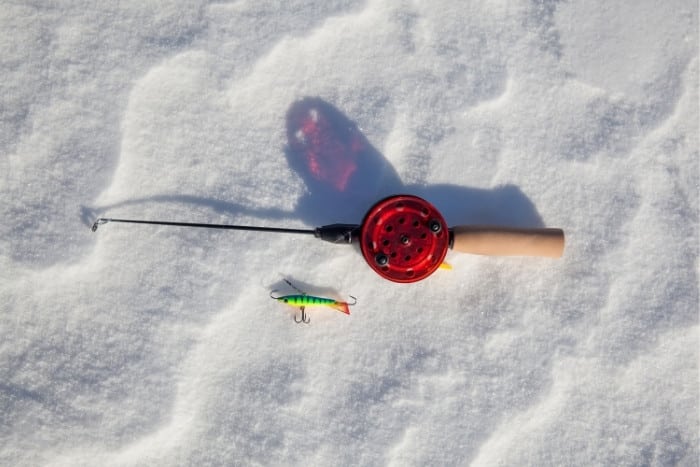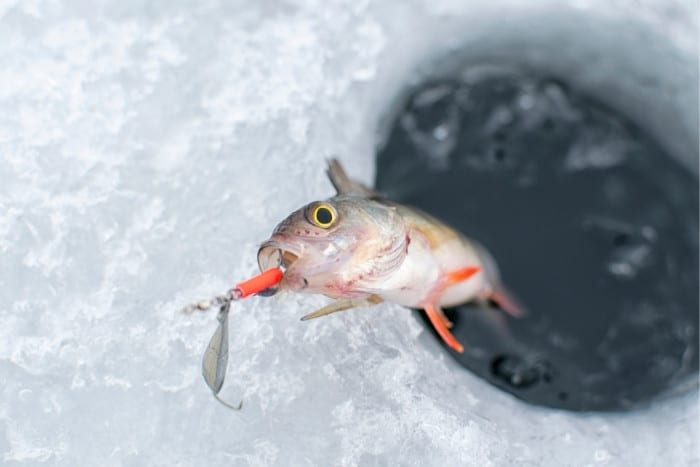Ice fishing rods come in lengths from 18” to 36” and longer. If you’re new to ice fishing and wondering where to start, you might wonder if it matters what size ice fishing rod you choose.
The best length for an ice fishing rod is 24-27”, giving you a wide range of uses. This size is perfect for small ice fishing huts where space is a premium, allows you to detect subtle bites, and has enough backbone to reel in big fish. However, more than just length is essential to consider.
Keep reading below, and we’ll cover why ice fishing rods are short when you want other lengths and other factors in selecting one.
What Length Ice Fishing Rod Is Best For What Purpose?
While the “best length” for an ice fishing rod is a subjective term, some standard sizes are recommended over others for a good reason.
We’ll break down the general size categories of ice fishing rods below and their role.
Selecting the best rod for you will depend on the size of fish you are targeting, how much space you have, and your technique.
1. Under 24” Ice Fishing Rods For Truly Ultralight Ice Fishing
Ice fishing rods under two feet are not the most common size, but if you consistently target small fish and need the extra space, then a sub-two-foot rod might work well for you.
For panfish and stocked trout, smaller rods offer additional sensitivity and make the fight with a small fish much more exciting. Smaller rods have other practical benefits as well.
The shorter the rod, the more portable and packable it is if you’re limited on space and what you can bring.
It makes it super easy to pack up and move from hole to hole and makes unpacking when you get to your spot a breeze.

2. 24”-27” Is The Most Versatile Length To Go For
Rods in this size are also the most common ice fishing rod you’ll find and are the most recommended size for beginners.
Choosing a fishing rod in this length will give you the most flexibility in where you can use it.
A rod between 24” to 27” is easy to use in an ice fishing hut without taking up much space while offering extra backbone to fight the fish.
Rods in this range are still small enough to be easily controlled, so you can keep your line in the middle of the hole and easily see when you’re getting a bite.
This short size also makes it easy to use in any ice fishing hut, where space is a premium, and a short ice fishing rod will save space for you and anyone else in the area.
3. 27”-32” Is Great When Fishing With Extra Space
If you usually fish in a larger ice fishing hut or ice fish outside, a 27-32 inch rod might work well for you.
While this could be overkill for small fish, it’ll make you more likely to land big fish and offers extra flexibility to be more forgiving when the fish fights back.
While this is on the longer side of an ice fishing rod, it is still small enough that you can really feel what is going on when jigging.
Make sure to choose one that is sensitive since fish bite light when the water is cold, and you don’t want to miss a bite.
4. Over 32” Rods For Fighting Big Fish
If you are targeting trophy-sized fish and have the space, a longer rod might be in order.
Experienced ice fishermen will use a longer ice fishing rod to have the best shot at landing a big fish who’ll put on a good fight, even in the winter.
While 3+ foot ice fishing rods are overkill for small fish, if that’s what you already have, there’s no reason you can’t use it anyway.
If you want to get out and go ice fishing, and all you have is your 6’6” bass fishing rod, you could use that!
However, having a longer fishing rod will make you more prone to break-offs, and it’s harder to control/see what is going on, so a 27” rod will be better for most people.
Why Are Ice Fishing Rods So Short?
Below are some reasons why ice fishing rods are so short and in more detail than above.
Selecting the right ice fishing rod is more important than just the length of the rod, so it’s good to understand what to look for when choosing one.
1. It Is Easy To See When You Have A Bite
While length is not the only factor in detecting bites, it is easier to see when the tip of the rod is only 2 feet in front of your face rather than 5 feet.
Fish also bite much softer in the winter, and detecting a subtle bite is crucial. The amount of the rod that bends and how easy it is to notice depends on the rod’s action and power.
Action is how much of the rod bends, and power is how much force it takes to bend it.
The best all-around choice for ice fishing is a medium power, fast action rod with a sensitive tip and enough give to reel in a big fish. However, this size rod will not be too overkill for reeling in smaller fish.
Fast action will bend from the tip to about 30-35% down the rod, and a medium power will allow most fish to cause it to bend. The rest of the rod that doesn’t bend is called the backbone.
Medium action rods will bend a bit more and be more forgiving when fighting a larger fish, especially when they shake their heads and try to lose the lure or run with the line.

2. You Don’t Need To Cast As Far
Traditional fishing rods are longer than ice fishing rods partly because the additional length makes it possible to cast it further.
Casting a fishing rod relies on the momentum of your cast being amplified by the length of the fishing rod. While other factors are involved, as a general rule, the longer the rod, the further it casts.
There’s no need to cast far for ice fishing since you are just dropping your lure above the hole, making the extra length of a traditional fishing rod useless for ice fishing.
One of the other benefits of a longer rod is that they can be more forgiving when fighting a fish, in combination with the action, and since fish are more sluggish and lethargic during winter, they put up less of a fight.
3. It Is Easy To Control A Short Ice Fishing Rod
Finally, it is easy to control a short fishing rod, which can be important to keep the line away from the edges of the ice that can cut it, and when fishing in tight spaces.
Setting the hook in an enclosed space can be risky with a longer rod and send your hook flying. With a shorter fishing rod, you have more control, and it is less likely that your hook will go awry when setting it.
Conclusion
As you can tell, there can be a lot to consider when purchasing an ice fishing rod.
With so many different lengths available for purchase, and some being only an inch or two apart, you now know why there are so many options.
Selecting the right ice fishing rod depends on where you’re fishing, what species you’re targeting, and choosing the right action and power for your needs.
However, for most people, a 24-27” rod will work 95% of the time.
